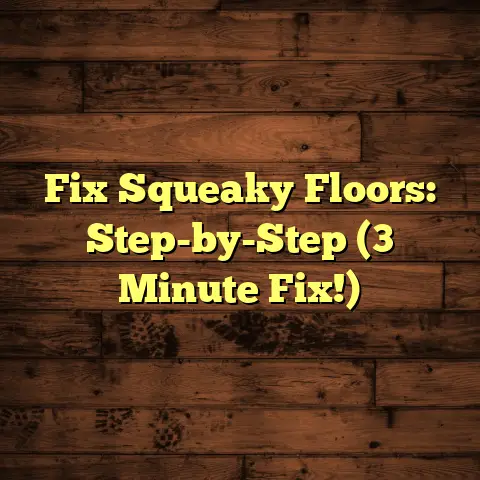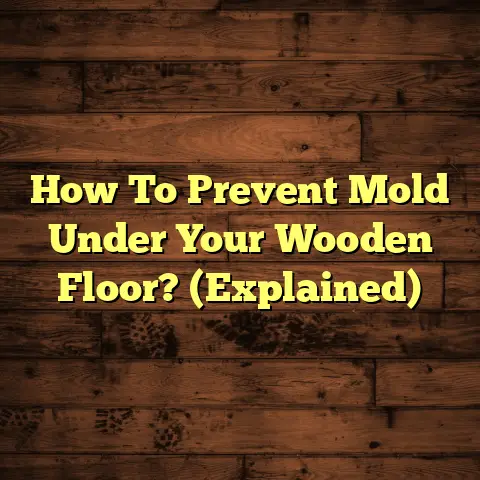Disinfecting Hardwood Safely (3 Finishes Ruined!)
With everyone hyper-focused on keeping their homes clean and germ-free, I’ve noticed a worrying trend.
People are unknowingly destroying their beautiful hardwood floors in the name of disinfecting!
Trust me, I get it. We all want a safe and healthy home.
But blindly attacking your floors with harsh chemicals? That’s a recipe for disaster.
I’m talking about finishes peeling, clouding, and even completely dissolving before your eyes.
I’ve personally witnessed three heartbreaking cases recently where homeowners wrecked their floors, and it’s what inspired me to write this article.
So, let’s dive into the world of disinfecting hardwood floors and learn how to do it safely!
The Intersection of Innovation and Home Care
Think about it: cleaning products have come a long way, right?
From simple soaps to powerful disinfectants, innovation has given us more options than ever.
We’re constantly bombarded with new formulas and technologies promising to obliterate germs and keep our homes sparkling clean.
And with all that’s been going on in the world, it’s no wonder we’re all a little more obsessed with hygiene.
But here’s the thing: not all cleaning solutions are created equal, especially when it comes to hardwood floors.
What works wonders on your kitchen counter could be a death sentence for your beautiful wood finish.
That’s why understanding the science behind disinfecting and its impact on different types of hardwood finishes is absolutely crucial.
Section 1: Understanding Hardwood Finishes
1.1 What Are Hardwood Finishes?
Okay, let’s start with the basics. What exactly is a hardwood finish?
Well, it’s essentially a protective layer applied to the surface of your wood floor.
It’s like a shield, guarding the wood from moisture, scratches, stains, and everyday wear and tear.
Think of it as the floor’s personal bodyguard!
There are several types of finishes out there, but the most common ones I see are:
Urethane Finishes: These are super popular because they’re durable, water-resistant, and relatively low-maintenance.
They come in various sheens, from glossy to matte.Oil-Based Finishes: These finishes penetrate the wood, providing a rich, warm look.
They’re known for their durability, but they can take longer to dry and cure.Water-Based Finishes: These are a great option for the environmentally conscious homeowner.
They’re low in VOCs (volatile organic compounds), dry quickly, and offer good protection.
Each finish has its own unique properties and characteristics, so it’s important to know what kind you have on your floor.
Not sure?
Check your original flooring paperwork, or
consult with a flooring professional (like yours truly!).
1.2 The Importance of Choosing the Right Finish
Choosing the right finish is like picking the perfect outfit for a special occasion.
It needs to look good, feel comfortable, and protect you from the elements.
Similarly, the right finish can enhance the beauty of your hardwood floor, extend its lifespan, and make it easier to maintain.
Think about it: a durable urethane finish can withstand heavy foot traffic and spills, while an oil-based finish can add a touch of elegance to a formal living room.
The finish also plays a crucial role in protecting the wood from moisture.
Water is the enemy of hardwood, causing it to swell, warp, and even rot over time.
A good finish acts as a barrier, preventing water from seeping into the wood and causing damage.
Ultimately, the right finish is an investment in the long-term health and beauty of your hardwood floors.
Section 2: The Need for Disinfecting Hardwood Floors
2.1 Health and Safety Concerns
Okay, let’s talk about why we’re even having this conversation: germs!
In today’s world, we’re all more aware than ever of the importance of keeping our homes clean and hygienic.
And that includes our floors, which can be a breeding ground for all sorts of nasty pathogens.
Think about it: we track in dirt, mud, and who knows what else on our shoes.
Kids and pets crawl around on the floor, spreading germs everywhere.
And let’s not forget about those accidental spills and messes that can attract bacteria and mold.
According to the National Sanitation Foundation (NSF),
shoe bottoms harbor an average of 421,000 bacteria,
including E.
coli and Klebsiella pneumoniae.
These pathogens can cause a range of illnesses, from mild stomach upset to more serious infections.
That’s why disinfecting your hardwood floors is especially important in high-traffic areas, homes with young children, and households with pets.
It’s all about creating a healthier living environment for you and your family.
2.2 Common Cleaning Practices
So, how do most people clean their hardwood floors?
Well, I’ve seen it all.
Some folks stick to the basics: sweeping, vacuuming, and mopping with a mild soap and water solution.
Others reach for the all-purpose cleaners, hoping to kill germs and remove stains in one fell swoop.
And then there are those who swear by home remedies like vinegar and baking soda.
While these traditional cleaning methods can be effective at removing dirt and grime, they often fall short when it comes to disinfecting.
Many common household cleaners simply aren’t designed to kill viruses and bacteria.
They might make your floors look clean, but they could still be harboring harmful pathogens.
Plus, some of these practices can actually damage your hardwood finish over time.
Harsh chemicals can strip away the protective layer, leaving your floors vulnerable to moisture and wear.
And abrasive cleaners can scratch and dull the surface, ruining its natural beauty.
Section 3: Disinfecting Agents and Their Effects on Finishes
3.1 Overview of Common Disinfectants
Alright, let’s get down to the nitty-gritty: disinfectants!
There’s a whole arsenal of disinfecting agents out there, each with its own strengths and weaknesses.
Here’s a rundown of some of the most popular ones:
Bleach: This is a powerful disinfectant that can kill a wide range of pathogens.
However, it’s also highly corrosive and can damage many hardwood finishes.Hydrogen Peroxide: This is a milder disinfectant than bleach, but it’s still effective against many bacteria and viruses.
It’s generally considered safer for hardwood floors, but it can still cause discoloration if used improperly.Alcohol-Based Cleaners: These cleaners are fast-drying and effective against many germs.
However, they can also strip away the moisture from hardwood finishes, leading to cracking and dullness.Vinegar: This is a natural disinfectant that’s often used as a home remedy.
However, it’s also acidic and can damage certain hardwood finishes over time.Quaternary Ammonium Compounds (Quats): These are commonly found in disinfectant wipes and sprays.
They’re effective against many pathogens, but some can leave a residue on hardwood floors.
It’s important to remember that not all disinfectants are created equal.
Some are more effective against certain pathogens than others.
And some are more likely to damage your hardwood finish.
That’s why it’s crucial to do your research and choose a disinfectant that’s both effective and safe for your floors.
3.2 The Science of Damage
Okay, let’s put on our lab coats and dive into the science of how disinfectants can damage hardwood finishes.
The key is understanding the chemical interactions between the disinfectant and the finish.
Many disinfectants contain harsh chemicals that can break down the molecular structure of the finish.
For example, bleach is a strong oxidizing agent that can corrode urethane finishes, causing them to become cloudy or peel.
Alcohol-based cleaners can dissolve the oils in oil-based finishes, leading to cracking and dullness.
And acidic solutions like vinegar can etch into water-based finishes, leaving behind permanent stains.
The type of damage also depends on the concentration of the disinfectant and the length of exposure.
A diluted solution of bleach might not cause immediate damage, but repeated use over time can still weaken the finish.
And a concentrated solution of alcohol can strip away the finish in a matter of minutes.
That’s why it’s so important to follow the manufacturer’s instructions carefully and always test the disinfectant on a small, inconspicuous area of your floor before applying it to the entire surface.
Section 4: Case Studies of Ruined Finishes
Alright, let’s get to the real-life horror stories.
These are the cases where I’ve personally witnessed homeowners accidentally destroying their hardwood floors with disinfectants.
Prepare to cringe!
4.1 Case Study 1: Urethane Finish Gone Wrong
I had a client, let’s call her Sarah, who was a total clean freak.
She was obsessed with keeping her house spotless, especially after her kids started bringing home germs from school.
So, she started using a bleach-based disinfectant on her urethane-finished hardwood floors.
She figured, “Bleach kills everything, right?”
Well, she was right about the germs, but she was dead wrong about the floor.
After a few weeks, she started noticing that the finish was looking cloudy and dull.
Then, it started to peel and crack.
Eventually, the entire floor looked like it had been through a war.
The bleach had corroded the urethane finish, leaving behind a sticky, unsightly mess.
I had to break the bad news to Sarah: her floors were ruined and needed to be completely refinished.
It was a costly and time-consuming process, all because of a simple misunderstanding about disinfectants.
4.2 Case Study 2: Oil-Based Finish Disaster
Another client, let’s call him Tom, had beautiful oil-based hardwood floors in his living room.
He loved the rich, warm look of the finish, but he was also concerned about germs.
So, he started using an alcohol-based cleaner on his floors, thinking it would be a safe and effective way to disinfect them.
Big mistake!
Alcohol is a solvent, which means it can dissolve oils and fats.
In this case, it dissolved the oils in the oil-based finish, leaving the wood dry and brittle.
The floor started to crack and splinter, and the finish lost its luster.
Tom was devastated.
He had spent a fortune on those
floors, and now they were ruined.
He ended up having to sand down the entire floor and apply a new oil-based finish.
It was a painful lesson in the importance of understanding the properties of different finishes and disinfectants.
4.3 Case Study 3: Water-Based Finish Failure
My third case involves a homeowner, let’s call her Emily, who was a big fan of natural cleaning products.
She had heard that vinegar was a great disinfectant, so she started using a vinegar solution on her water-based hardwood floors.
While vinegar is a natural disinfectant, it’s also acidic.
And acids can damage water-based finishes over time.
In Emily’s case, the vinegar etched into the finish, leaving behind permanent stains and discoloration.
The floor looked dull and lifeless, and no amount of cleaning could restore its original beauty.
Emily learned the hard way that even natural cleaning products can be harmful to hardwood floors if used improperly.
She had to hire a professional to buff out the stains and apply a new coat of finish.
Section 5: Best Practices for Disinfecting Hardwood Safely
Okay, enough with the horror stories!
Let’s talk
about how to disinfect your hardwood floors safely
and effectively.
5.1 Recommended Cleaning Products
The key is to choose cleaning products that are specifically designed for hardwood floors and that are known to be safe for your finish.
Here are a few of my top recommendations:
-
Bona Hardwood Floor Cleaner: This is a popular and widely available cleaner that’s pH-neutral and safe for all types of hardwood finishes.
Murphy Oil Soap: This classic cleaner is gentle and effective at removing dirt and grime without damaging the finish.
However, it can leave a residue if used improperly, so be sure to follow the instructions carefully.-
Microfiber Mops: These mops are great for cleaning hardwood floors because they’re gentle, absorbent, and effective at removing dirt and dust.
Disinfectant Wipes for Hardwood Floors: Some companies now make disinfectant wipes that are specifically designed for hardwood floors.
These wipes are typically pH-neutral and contain ingredients that won’t damage the finish.
Always read the labels carefully and follow the manufacturer’s instructions.
And when in doubt, test the product on a small, inconspicuous area of your floor before applying it to the entire surface.
5.2 Safe Disinfecting Techniques
Alright, let’s talk about the proper techniques for disinfecting hardwood floors.
Here’s a step-by-step guide:
-
Sweep or Vacuum: Start by removing any loose dirt, dust, and debris from the floor.
-
Prepare Your Cleaning Solution: Dilute your chosen cleaner according to the manufacturer’s instructions.
Dampen Your Mop: Dip your microfiber mop into the cleaning solution and wring it out thoroughly.
You want the mop to be damp, not soaking wet.-
Mop the Floor: Mop the floor in the direction of the wood grain.
-
Dry the Floor: Use a clean, dry microfiber cloth to dry the floor immediately after mopping.
-
Ventilate the Room: Open windows and doors to allow the floor to air dry completely.
Important Tips:
- Never pour cleaning solution directly onto the floor.
- Avoid using abrasive cleaners or scrub brushes.
- Don’t let water puddle on the floor.
- Clean up spills immediately.
5.3 Routine Maintenance Tips
Okay, let’s talk about how to incorporate disinfecting into your regular cleaning routine without harming your floors.
I recommend disinfecting your hardwood floors once a week, or more often if you have young children or pets.
Here are a few tips to keep in mind:
-
Use a pH-Neutral Cleaner: Choose a cleaner that’s pH-neutral to avoid damaging the finish.
-
Don’t Overdo It: Disinfecting too often can actually strip away the finish and make your floors more vulnerable to damage.
-
Protect Your Floors: Use rugs and mats in high-traffic areas to protect your floors from wear and tear.
-
Clean Up Spills Immediately: Wipe up spills as soon as they happen to prevent staining and water damage.
-
Regularly Dust and Vacuum: Dust and vacuum your floors regularly to remove dirt and debris that can scratch the finish.
Conclusion: Balancing Safety and Care
So, there you have it! A comprehensive guide to disinfecting hardwood floors safely.
Remember, it’s all about finding the right balance between maintaining a healthy living environment and protecting your beautiful floors.
Choose your cleaning products wisely, follow the manufacturer’s instructions carefully, and don’t be afraid to ask for help from a flooring professional.
With a little knowledge and care, you can keep your hardwood floors looking their best for years to come.
And who knows, maybe you’ll even inspire your neighbors to do the same!
I hope this article has been helpful.
Happy cleaning!





